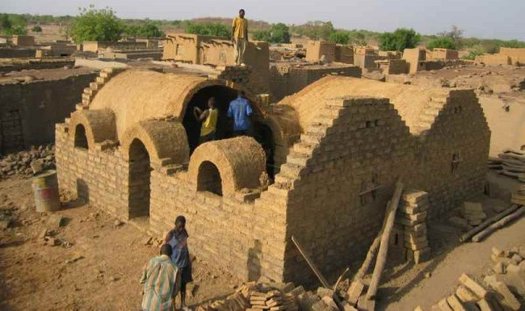
April 26, 2013
A Roof, A Skill, A Market

Photo: Nubian Vault Association
One hundred million people living in the Sahel region of West Africa are either homeless, or live precariously in short-life structures. Because deserts are spreading, the bush timber they once used to build homes is no longer available; as a result, they are forced to use imported wood and corrugated iron to build houses. These modern materials have poor insulation properties, are unhealthy and uncomfortable to live with and cost cash to purchase that many poor families simply don’t have.
To reverse this downward spiral into poverty, the Nubian Vault Association (AVN) has evolved a unique approach that creates three kinds of value within local economies: a roof, a skill and a market.
The roof in question is inspired by a building type, the nubian vault, invented by the Egyptians 3500 years ago. Adapted for today’s conditions, these vaulted earth roofs are built with locally-made adobe bricks whose raw materials are free and locally available. Because nubian vault structures contain no wood, or iron, they are affordable, ecological, and — with their excellent thermal properties — comfortable. They are also durable: AVN houses built more than ten years ago are still in daily use and can be expected to last 50 years or more; this compares with an average life expectancy of 7-10 years for a house with a corrugated iron roof and thin concrete block walls.
Skills are created as the cohort of masons trained by AVN grows. Since 2000, 261 masons have been trained and a further 300 apprentices are following in their steps by learning and working on new sites. This transmission of know-how between master and apprentice is at the core of AVN’s approach.
AVN has an explict approach, too, to the creation of self-sustaining local markets. They begin with a demonstration project —for a small mosque, perhaps — and then recruit a dynamic and confident individual to be their ‘ambassador’. He or she looks for new customers among up within a 100km radius of the demonstration project. New customers, as they are found, are connected with a mason. Unlike many architecture-for-good efforts, AVN does not build homes for local people, and it does not give or lend them money to do so. On the contrary: new clients usually participate in the construction of their own house and pay the masons directly.
AVN supports this process with advice on the recruitment of local apprentices, and helps with the logistics and planning of the first construction sites in new markets. Its local teams also organise two to three day congresses at the start and end of each construction season to which all NV masons are invited. They use these events to swap experiences and tips, make contacts, and network. AVN also provides training workshops on skills needed to run a small business and become a successful entrepreneur.
AVN’s core objective is to create autonomous local markets that do not depend on external inputs of cash. Right now, 35 percent of new customers are found by the builders themselves.“It’s like priming a pump”, Granier explains; “our work expands on the famous saying: we teach a man to fish; we teach him how to mend the nets; we teach him how to sell the fish”.
In the language of impact and outputs, AVN’s record is impressive: More than 300 villages contain at least one nubian vault, and eight AVN offices have been opened opened in Burkina-Faso, Mali and Senegal. Twelve thousand people live, sleep or regularly use one of the 1,600 nubian vaults built so far. And because only earth, rocks and water have been used in their construction, more than 3,300 trees and 19,000 iron sheets have not been consumed, and more than $1.5m of business been generated in cash or barter/exchange equivalent —and stayed in the local economy. Thirty five percent of the nubian vault market is fully autonomous — that is, more than a third of all new nubian vaults are built without any contact with AVN.
For Granier, counting ‘units’ is not enough — the AVN project is not like ramping up production in a factory. Rather, they need to understand two things: first, what factors determine the readiness of an area to become self-sufficient — its “market-readiness”? Second — and most important: what conditions are needed for the exponential growth of the AVN approach?
One of the necessary conditions, it seems to this writer, is time. For AVN, with 14 hard-working years under its belt, its time may well be now.
The AVN story will be presented at an earth architecture conference in Portugal on 2 and 3 May.
Observed
View all
Observed
By John Thackara
Related Posts

Business
Courtney L. McCluney, PhD|Essays
Rest as reparations: reimagining how we invest in Black women entrepreneurs

Design Impact
Seher Anand|Essays
Food branding without borders: chai, culture, and the politics of packaging

Graphic Design
Sarah Gephart|Essays
A new alphabet for a shared lived experience

Arts + Culture
Nila Rezaei|Essays
“Dear mother, I made us a seat”: a Mother’s Day tribute to the women of Iran
Recent Posts
Courtney L. McCluney, PhD|Essays
Rest as reparations: reimagining how we invest in Black women entrepreneurs Food branding without borders: chai, culture, and the politics of packaging Why scaling back on equity is more than risky — it’s economically irresponsible Beauty queenpin: ‘Deli Boys’ makeup head Nesrin Ismail on cosmetics as masks and mirrorsRelated Posts

Business
Courtney L. McCluney, PhD|Essays
Rest as reparations: reimagining how we invest in Black women entrepreneurs

Design Impact
Seher Anand|Essays
Food branding without borders: chai, culture, and the politics of packaging

Graphic Design
Sarah Gephart|Essays
A new alphabet for a shared lived experience

Arts + Culture
Nila Rezaei|Essays
